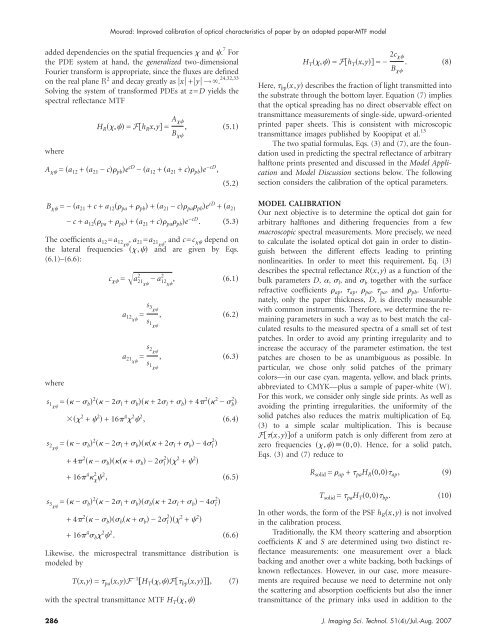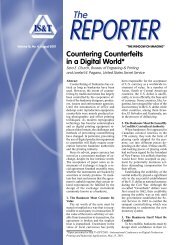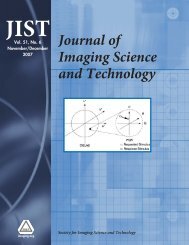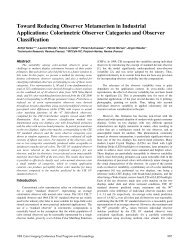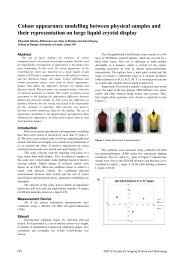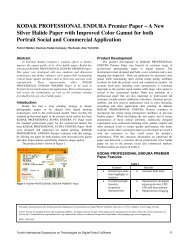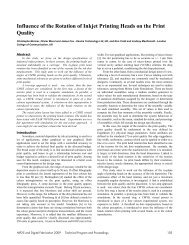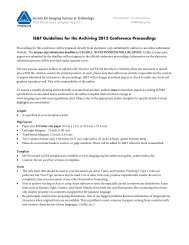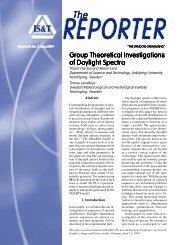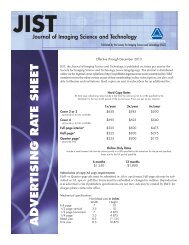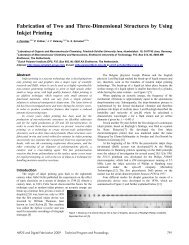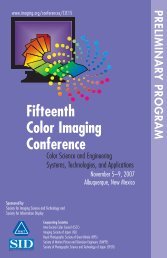Additional Material, Journal of Imaging Science - Society for Imaging ...
Additional Material, Journal of Imaging Science - Society for Imaging ...
Additional Material, Journal of Imaging Science - Society for Imaging ...
You also want an ePaper? Increase the reach of your titles
YUMPU automatically turns print PDFs into web optimized ePapers that Google loves.
Mourad: Improved calibration <strong>of</strong> optical characteristics <strong>of</strong> paper by an adapted paper-MTF model<br />
added dependencies on the spatial frequencies and . 7 For<br />
the PDE system at hand, the generalized two-dimensional<br />
Fourier trans<strong>for</strong>m is appropriate, since the fluxes are defined<br />
on the real plane R 2 and decay greatly as x +y →. 24,32,33<br />
Solving the system <strong>of</strong> trans<strong>for</strong>med PDEs at z=D yields the<br />
spectral reflectance MTF<br />
where<br />
H R , = Fh R x,y = A <br />
B <br />
,<br />
A = a 12 + a 21 − c pb e cD − a 12 + a 21 + c pb e −cD ,<br />
5.1<br />
5.2<br />
B =−a 21 + c + a 12 pa + pb + a 21 − c pa pb e cD + a 21<br />
− c + a 12 pa + pb + a 21 + c pa pb e −cD . 5.3<br />
The coefficients a 12 =a 12 , a 21 =a 21 , and c=c depend on<br />
the lateral frequencies , and are given by Eqs.<br />
(6.1)–(6.6):<br />
where<br />
2 2<br />
c =a 21 − a 12 , 6.1<br />
a 12 =<br />
a 21 =<br />
s 3<br />
s 1<br />
,<br />
s 2<br />
s 1<br />
,<br />
6.2<br />
6.3<br />
s 1 = − b 2 −2 l + b +2 l + b +4 2 2 − b 2 <br />
2 + 2 +16 4 2 2 ,<br />
s 2 = − b 2 −2 l + b +2 l + b −4 l 2 <br />
+4 2 − b + b −2 l 2 2 + 2 <br />
6.4<br />
+16 4 2 2 , 6.5<br />
s 3 = − b 2 −2 l + b b +2 l + b −4 l 2 <br />
+4 2 − b b + b −2 l 2 2 + 2 <br />
+16 4 b 2 2 . 6.6<br />
Likewise, the microspectral transmittance distribution is<br />
modeled by<br />
Tx,y = pa x,yF −1 †H T ,F bp x,y‡,<br />
with the spectral transmittance MTF H T ,<br />
7<br />
H T , = Fh T x,y =− 2c <br />
B <br />
.<br />
Here, bp x,y describes the fraction <strong>of</strong> light transmitted into<br />
the substrate through the bottom layer. Equation (7) implies<br />
that the optical spreading has no direct observable effect on<br />
transmittance measurements <strong>of</strong> single-side, upward-oriented<br />
printed paper sheets. This is consistent with microscopic<br />
transmittance images published by Koopipat et al. 13<br />
The two spatial <strong>for</strong>mulas, Eqs. (3) and (7), are the foundation<br />
used in predicting the spectral reflectance <strong>of</strong> arbitrary<br />
halftone prints presented and discussed in the Model Application<br />
and Model Discussion sections below. The following<br />
section considers the calibration <strong>of</strong> the optical parameters.<br />
MODEL CALIBRATION<br />
Our next objective is to determine the optical dot gain <strong>for</strong><br />
arbitrary halftones and dithering frequencies from a few<br />
macroscopic spectral measurements. More precisely, we need<br />
to calculate the isolated optical dot gain in order to distinguish<br />
between the different effects leading to printing<br />
nonlinearities. In order to meet this requirement, Eq. (3)<br />
describes the spectral reflectance Rx,y as a function <strong>of</strong> the<br />
bulk parameters D, , l , and b together with the surface<br />
refractive coefficients ap , ap , pa , pa , and pb . Un<strong>for</strong>tunately,<br />
only the paper thickness, D, is directly measurable<br />
with common instruments. There<strong>for</strong>e, we determine the remaining<br />
parameters in such a way as to best match the calculated<br />
results to the measured spectra <strong>of</strong> a small set <strong>of</strong> test<br />
patches. In order to avoid any printing irregularity and to<br />
increase the accuracy <strong>of</strong> the parameter estimation, the test<br />
patches are chosen to be as unambiguous as possible. In<br />
particular, we chose only solid patches <strong>of</strong> the primary<br />
colors—in our case cyan, magenta, yellow, and black prints,<br />
abbreviated to CMYK—plus a sample <strong>of</strong> paper-white (W).<br />
For this work, we consider only single side prints. As well as<br />
avoiding the printing irregularities, the uni<strong>for</strong>mity <strong>of</strong> the<br />
solid patches also reduces the matrix multiplication <strong>of</strong> Eq.<br />
(3) to a simple scalar multiplication. This is because<br />
Fx,y<strong>of</strong> a uni<strong>for</strong>m patch is only different from zero at<br />
zero frequencies ,0,0. Hence, <strong>for</strong> a solid patch,<br />
Eqs. (3) and (7) reduce to<br />
R solid = ap + pa H R 0,0 ap ,<br />
T solid = pa H T 0,0 bp .<br />
8<br />
9<br />
10<br />
In other words, the <strong>for</strong>m <strong>of</strong> the PSF h R x,y is not involved<br />
in the calibration process.<br />
Traditionally, the KM theory scattering and absorption<br />
coefficients K and S are determined using two distinct reflectance<br />
measurements: one measurement over a black<br />
backing and another over a white backing, both backings <strong>of</strong><br />
known reflectances. However, in our case, more measurements<br />
are required because we need to determine not only<br />
the scattering and absorption coefficients but also the inner<br />
transmittance <strong>of</strong> the primary inks used in addition to the<br />
286 J. <strong>Imaging</strong> Sci. Technol. 514/Jul.-Aug. 2007


